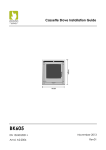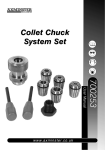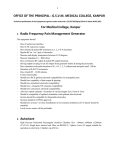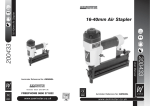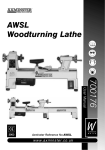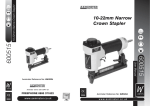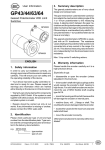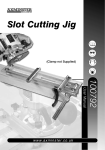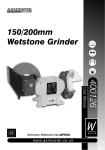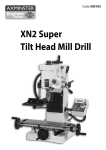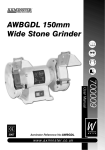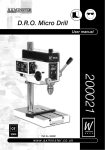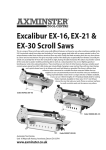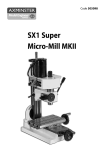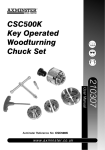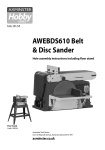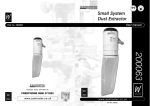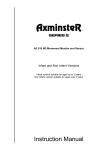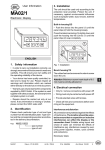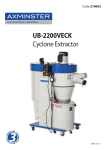Download Ax-White Manual Master
Transcript
User Manual CMT650 Kitchen Worktop Jig Part no:200650 w w w. a x m i n s t e r. c o . u k CMT650 www.cmtuk.com Index of Contents... Page No. Index of Contents...................................................................................................................02 What’s in the Box………….………........……..…………..........................................................03 What else you will need....................................................................................... 04 General Safety Instructions............................................................................... 05.06 CMT worktop jig configuration.............................................................................. 07 General guidelines for cutting Worktop joints...................................................... 08 Cutting 90 degree worktop joints................................................................ 09,10,11 Cutting out of square joints.................................................................................... 12 Cutting 45-degree worktop joints......................................................................12,13 Cutting the worktop joint clamp recesses............................................................. 13 Assembling worktop joints......................................................................................14 Other applications for the CMT650 worktop jig................................................14,15 Saf y Helm fet sp irator Re Sa Two E R Ey fety Viso Sa Safety Protection Symbols et st Mask Du F ootw ety r Def ende rs n ar s ve ro tectio eP tiv e Glo tec r ea n Asse Ma bly m al d Manu ea Pro ! The symbols shown on the cover of this manual advise that you wear the correct safety protection when using this machine. SAFETY!! What’s in the Box... Model Number: CMT650 1 No. A CMT 650 Phenolic plastic worktop jig 3 No. B Positioning stops fitted with rubber O-rings (2 rings per stop) 1 No. C Phenolic length stop finger 1 No. D M6 Butterfly Screw 1 No. E M6 Caphead bolt 2 No. F M6 washer 1 No. Instruction Manual A B D C F PHONE 0845 6040064 E 03 What else you will need... A Heavy duty router with 12.7mm (1/2") collet B 30mm guide bush C Collet spanner and guide bush fixing screws D Pair of clamps (ideally long reach with soft facings or pads to protect face of worktop) E 12.7mm x 50mm (40mm for thinner worktops) router cutter (either CMT 812628 2 flute cutter or CMT 652-628 replaceable tip cutter). F Ear protectors and safety goggles or visor A F B C D 04 E www.cmtuk.com General Safety Instructions... Good Working Practices/Safety The following suggestions will enable you to observe good working practices, keep yourself and fellow workers safe and maintain your tools and equipment in good working order. ! WARNING!! KEEP TOOLS AND EQUIPMENT OUT OF THE REACH OF YOUNG CHILDREN Safety Guide Lines 1. Ensure that you are conversant with using the router before attempting to use this Jig. 2. Always follow the router manufacturers guidelines and safety procedures. 3. If you have not used a worktop jig previously, make a series of trial cuts in scrap pieces of worktop to gain experience of the procedure, sequence and cutting characteristics of both the material, router and jig. 4. Always wear protective goggles and earmuffs when routing. 5. Always wear a dust mask or respirator and use dust extraction equipment whenever possible. 6. Avoid wearing loose clothing and keep long hair tied back. 7. Always remove spanners/keys from the router and do not leave them loose on the work surface or jig while routing. 8. Always switch off and wait until the router cutter has stopped rotating before lifting the router from the face of the work. 9. Always clamp the worktop to a secure rigid surface while cutting. 10. Whenever possible always cut the worktop joints before cutting the tops to length. PHONE 0845 6040064 05 General Safety Instructions... Cutters and Collets When cutting worktops the abrasive nature of the chipboard core and laminate faces rapidly wears the cutting edges of any cutter including tungsten carbide tipped cutters. Any cutter is unlikely to cut more than three complete worktop joints perfectly cleanly (i.e. male and female parts). Ensure that cutters are cleaned and sharpened (hand sharpened on a diamond stone) between cutting each complete joint. Ensure that the cutter is correctly held in the router collet (see router manufacturers instruction manual). Always check that the guide bush is fitted concentric to the cutter, preferably using a centering mandrel. 06 www.cmtuk.com CMT worktop jig configuration... For precise positioning on the worktop, the CMT worktop jig is fitted with three steel stops fitted into specific holes in the jig to suit each operation. Each stop is fitted with two neoprene o-rings to hold it securely into the hole. If the stop is difficult to fit, apply a drop of soap to the o-rings. Ensure that the stops are pushed fully into the holes flush to the underside of the jig. F C H G I E B D E D C A The holes for the steel stops are indicated by letters for each specific operation A. 2 holes - outer part of 45° joint B. 2 holes - outer part of 90° joint C. 4 holes - inner part of 90° and 45° joints D. 4 holes - fixing holes for clamps E. 3 holes - radius finishing of corners (r8,2) F. 2 holes - 45° finishing of corners G. 1 hole - inner part of 45° joint H. Stop holes to sail standard width worktops I. Slots for sliding stop fixing screw NOTE: The CMT jig must be used with a 30mm guide bush and a 12.7mm cutter fitted to the router. This allows for a cutter offset from the edge of the jig of 9 mm. PHONE 0845 6040064 07 General guidelines for cutting Worktop joints... Always ensure that you are cutting from the correct face and into the postform (rounded ) edge of the worktop. When cutting, the direction of rotation of the cutter (i.e. clockwise) will cut cleanly into the left hand side of the cut, but will tear the face off of the right hand side. Therefore the waste portion of the worktop must always be on the right hand side. When cutting worktops to length etc, use a jigsaw to cut away much of the waste to within 3mm of the required cut line and then trim the cut edge with the router guided against the edge of the jig. This will leave a straight square edge to align the jig stops against. Remember always cut into the post-form edge, never out of it. Always fit soft packing under the clamp heads when clamping against the laminate face of the worktop. When possible always leave the worktop over-length to allow the joint to be re-cut if incorrectly cut the first time. 08 www.cmtuk.com Cutting 90 degree worktop joints... Radius or 45˚corners Right Hand Joint Left Hand Joint Peninsula M M F F M F F M Rear edge of worktop against wall M: Male section F: Female section ! PLEASE NOTE When cutting a 90-degree joint to the right hand end of the worktop, have the worktop (decorative laminate) face up. For the abutting male section turn the worktop face down. When cutting a 90-degree joint to the left hand end of the worktop, have the worktop (decorative laminate) face down. For the abutting male section turn the worktop face up. Setting the width: The first step is to set the jig to suit the width of the worktop. If it is a standard width of worktop, then stop positions H can be used. If there is any discrepancy in the exact width or if the worktop is wider or narrower than this then the sliding width stop must be used. Stop positions H PHONE 0845 6040064 09 Cutting 90 degree worktop joints continued... Using the sliding stop: Always use a stop peg to set the jig to the correct worktop width wherever possible. But for Non standard worktops or where a top has been cut to a none standed width; position the sliding stop, fitting it to the underside of the jig with the clamping screw, secured by the clamping knob and washer, through the respective slot. (dependant on worktop width) Fit two stop pegs in holes B, hold these tight to the front face of he worktop, checking that the jig is square to it. Adjust the sliding stop up to the rear edge and tighten the clamp screw. Cutting the female edge: Position the stops in holes C on the jig (See Page 07). There is one stop that sits against the end of the worktop and two along the front face. The front stops are set in two of the four holes, the width of the worktop determining the distance apart. Ensure that all stops are tight against the worktop edges before clamping the jig to the worktop. Ensure that the clamps do not infringe the path of the router. Cutting: Make the cut in a series of shallow passes, the finer the cut the less effort being placed on the cutter and the easier it will be to control the router. Keep the feed speed constant and ensure that the router remains level on the face of the jig. Always work from left to right, keeping the guide bush against the edge. To finish, press the guide bush a little harder against the cut edge of the worktop and make a final fine pass across the full edge depth. 10 www.cmtuk.com Cutting 90 degree worktop joints continued... Cutting the male section: First turn and check that the worktop is the correct way up. When cutting the male edge, leave the sliding width stop or stop H in position and fit two stops in the holes B. Position and clamp the jig across the end of the worktop, ensuring that it is square to the front edge and that the stops are tight against the end. Support the waste end of the worktop to the jig using a clamp or by supporting it on a sacrificial work-surface below (to prevent it dropping and tearing the laminate at the end of the pass). Cut the joint face following the same routing procedure as for the female cut. Compensating for out of square walls: Slight variations can be accommodated with worktop jigs, but only up to approximately 3 degrees either way. However these joints will never be as precise as a true 90-degree worktop joint. The angle is always cut on the male section of worktop. Where possible place the worktops in position with the male section over the female. If space does not allow this, use a bevel gauge or other method to take off the angle and transfer it to the worktop. Remember which end you are cutting and turn them face up or down as necessary. Mark the inner edge of the female section on the underside of the male section. This line will be the cut line for the angled male section. Turn the male section over and mark the angled line clearly. From this line draw a line parallel to it and 9mm from it (to allow for the guide bush margin). See Fig 1: Fit the two stops into holes B on the jig and, with the sliding stop loose, position the jig over the worktop with the two stops against the front edge so that it is square. Check that the stops are tight against the front edge and clamp the jig to the worktop. Draw a line 8.5mm parallel to the edge of the jig. Position the pointed end of the sliding length stop against the end of this line and tighten the clamping screw. See Fig 2: Unclamp and remove the two front stops. Lay the jig on the cut line with the point of the sliding stop on the rear end of the angled cut line. Pivot the jig around this point until the guide edge is parallel to the angled cut line, but 8.5mm away from it. Clamp the jig securely to the worktop and cut the male joint following the routing procedure as before. PHONE 0845 6040064 11 Cutting out of square joints... Fig 1 B Fig 2 B Sliding stop Cutting line Sliding stop Cutting 45-degree worktop joints... To cut 45-degree corner joints on worktops, use the 22.5 mm angled end of the CMT 650 jig. As with 90-degree worktop joints, for 45-degree joints the worktop must be cut with the correct face upwards depending on whether it is a right or left-hand end or female or male joint edge. The first step when cutting 45-degree joints is to carefully set out and cut the 45-degree angle on the relative end of the worktop (leave the worktop over length if possible to allow joint to be re-cut if incorrect). When cutting worktops to length etc, use a jigsaw to cut away much of the waste to within 3mm of the required cut line and then trim the cut edge with the router guided against the edge of the jig or a straight edge. This will leave a straight square edge to align the jig stops against. Cutting the female edge (See Fig 3): Insert two stops into holes C and one into hole G. Position the jig on the worktop with the G stop against the front edge and the C stops against the angled cut edge. Make the cut with the router following the same procedure as for 90-degree joints. Cutting the male edge (See Fig 4): Insert the stops into holes A, hold them tight against the front edge of the worktop and clamp the jig firmly. Make the cut with the router following the same procedure as for 90-degree joints. 12 www.cmtuk.com Cutting 45-degree worktop joints... Fig 3 G C C Fig 4 A A Cutting the worktop joint clamp recesses... To cut the clamp recesses, fit two stops in the jig holes D. The positioning of the clamps should be no less than 100mm in from the front edge of the worktop. However the spacing between them can be as on the jig or altered to suit the worktop width. Remember to match them on both adjoining sections of worktop, setting-off from the front edge by measuring or transfer batten. Butt the stops against the joint edge and clamp it firmly. Cut the recesses to a depth so that the clamp bolt is approximately centred on the thickness of the worktop. The same 30mm guide bush and 12.7mm cutter is used for this operation, cutting in a series of shallow passes and taking out all of the waste from the recess. PHONE 0845 6040064 13 Assembling worktop joints... When assembling worktop joints it is advisable to insert biscuit dowels (size No 20) to assist in aligning the worktop surfaces and prevent movement between the faces. Recesses for the biscuits can be cut with the router or a biscuit jointer between the clamp recesses inserting no less than 4 dowels along a 600mm width of worktop. For biscuit jointer with a router use a 4mm x 47.6mmm arbor mounted slot cutter guided with a 22mm bearing to produce the slot for the biscuit. [Order no for biscuit joint cutter, arbor and bearing 310127 (1/2” shank) or 310126 (1/4” shank)]. The two cut chipboard faces of the joint must be sealed on assembly to prevent the ingress of water. This can be done using a fully waterproof adhesive or better, a coloured worktop sealant/adhesive. The latter are available in a range of colours that can be mixed and matched to blend with the colour of the worktop laminate. On cheaper worktops it may be found that the chipboard core spreads or breaks-out slightly on cutting. This will need to be trimmed back lightly with abrasive paper before assembly. Take care not to touch the laminate edge when doing this. Other applications for the CMT650 worktop jig... Radius corners and 45-degree corners: To cut radius corners on worktops and peninsular units, insert three stops into holes E and make the cut with the router in a series of shallow passes as previously described. E E 14 E www.cmtuk.com Other applications for the CMT650 worktop jig... To cut 45-degree corners on worktops and peninsular units, insert two stops into holes F and make the cut with the router in a series of shallow passes as previously described. F F PHONE 0845 6040064 15 Part no.200650 CMT650 CMT UK Unit 10 Weycroft Avenue Axminster Devon EX13 5PH PHONE 0845 6040064 Distributed by Jet Tools & Machinery Ltd www.cmtuk.com
















